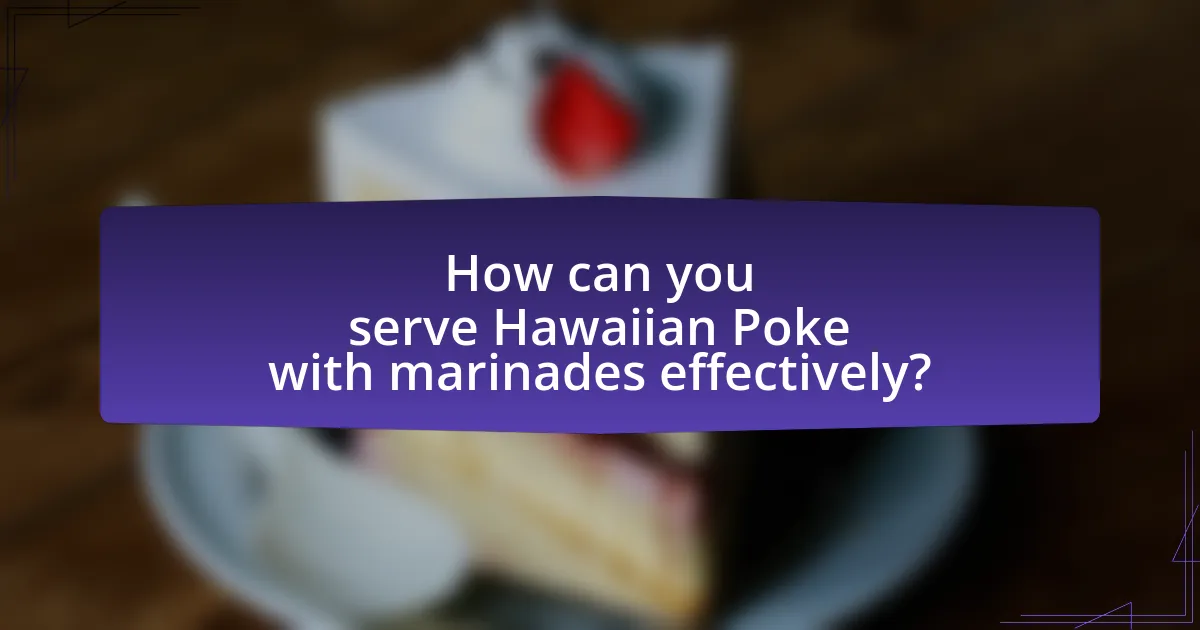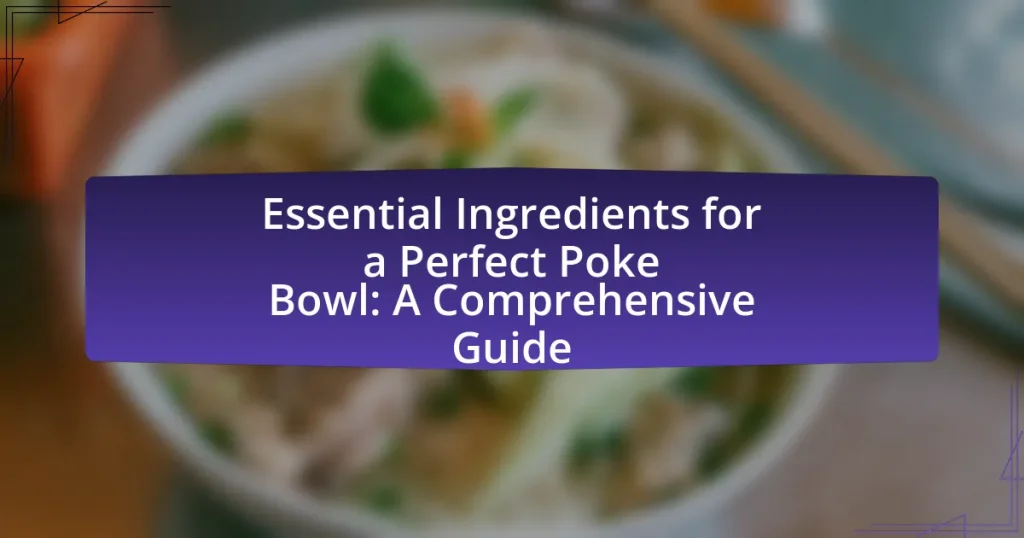The article focuses on the best marinades for authentic Hawaiian poke, highlighting key ingredients such as soy sauce, sesame oil, and green onions that create a traditional flavor profile. It explains how marinades enhance the fish’s flavor and texture, detailing the roles of acidity and oil in the marinating process. Additionally, the article discusses common ingredients, variations, and tips for crafting balanced marinades, as well as the importance of proper marination time to avoid compromising the fish’s quality. Accompaniments and garnishes that complement poke are also covered, providing a comprehensive guide to preparing and serving this iconic Hawaiian dish.

What are the Best Marinades for Authentic Hawaiian Poke?
The best marinades for authentic Hawaiian poke include soy sauce, sesame oil, and green onions. These ingredients create a traditional flavor profile that enhances the freshness of the fish. Soy sauce provides umami, while sesame oil adds a nutty richness, and green onions contribute a mild onion flavor. Additionally, incorporating ingredients like sea salt, Hawaiian sea salt in particular, and a touch of lime juice can elevate the taste further, aligning with traditional Hawaiian culinary practices.
How do marinades enhance the flavor of Hawaiian Poke?
Marinades enhance the flavor of Hawaiian Poke by infusing the fish with a combination of savory, sweet, and umami elements. The primary ingredients in marinades, such as soy sauce, sesame oil, and citrus juices, penetrate the fish, elevating its natural taste. For instance, soy sauce provides saltiness and depth, while citrus juices add brightness and acidity, balancing the richness of the fish. This flavor enhancement is crucial in Hawaiian Poke, where the freshness of the fish is complemented by the complex flavors of the marinade, creating a harmonious dish that is both refreshing and satisfying.
What ingredients are commonly used in Hawaiian Poke marinades?
Common ingredients used in Hawaiian Poke marinades include soy sauce, sesame oil, green onions, and sea salt. These ingredients create a savory and umami-rich flavor profile essential for authentic Poke. Soy sauce provides the salty base, while sesame oil adds a nutty aroma. Green onions contribute freshness, and sea salt enhances the overall taste.
How does the marinating process affect the texture of the fish?
The marinating process tenderizes the texture of the fish by breaking down proteins through the action of acids and enzymes in the marinade. This chemical reaction alters the fish’s muscle fibers, making them softer and more palatable. For example, citrus juices like lime or vinegar, commonly used in marinades, contain acids that denature proteins, leading to a more delicate texture. Additionally, marinating for an appropriate duration enhances moisture retention, preventing the fish from becoming dry during cooking.
What are the traditional marinades used in Hawaiian Poke?
Traditional marinades used in Hawaiian Poke primarily include soy sauce, sesame oil, and green onions. Soy sauce serves as the base for flavor, providing a salty and umami-rich profile. Sesame oil adds a nutty aroma and depth, while green onions contribute freshness and a mild onion flavor. These ingredients are often combined with additional elements like sea salt, limu (seaweed), and chili pepper for enhanced taste, reflecting the traditional Hawaiian approach to seasoning poke.
What is the role of soy sauce in Hawaiian Poke marinades?
Soy sauce serves as a key flavoring agent in Hawaiian Poke marinades, providing umami and saltiness that enhance the overall taste of the dish. The inclusion of soy sauce not only deepens the flavor profile but also helps to tenderize the fish, making it more palatable. Traditionally, soy sauce has been used in various Asian cuisines, and its incorporation into Poke reflects the cultural influences on Hawaiian cuisine, particularly from Japanese culinary practices.
How does sesame oil contribute to the flavor profile?
Sesame oil enhances the flavor profile by imparting a rich, nutty taste that complements various ingredients in marinades. This oil contains compounds such as sesamolins and sesamin, which contribute to its distinctive flavor and aroma. The unique taste of sesame oil balances the freshness of fish and vegetables commonly used in Hawaiian poke, making it a key component in achieving an authentic flavor experience.
What variations exist in Hawaiian Poke marinades?
Hawaiian Poke marinades vary primarily in their ingredients and flavor profiles, with common variations including shoyu (soy sauce), sesame oil, and green onions. Traditional marinades often feature a base of shoyu, which provides a salty umami flavor, while sesame oil adds richness. Other variations incorporate ingredients like sea salt, chili pepper, and limu (seaweed) for added texture and taste. Additionally, some recipes may include citrus juices, such as lime or lemon, to introduce acidity and brightness. These variations reflect regional preferences and personal tastes, contributing to the diverse culinary landscape of Hawaiian Poke.
How do different regions influence marinade recipes?
Different regions influence marinade recipes by incorporating local ingredients, cultural traditions, and climate conditions. For example, Hawaiian marinades often feature soy sauce, sesame oil, and local fruits like pineapple, reflecting the islands’ Asian and tropical influences. In contrast, Mediterranean marinades may use olive oil, lemon juice, and herbs, showcasing the region’s agricultural bounty and culinary practices. These regional variations are rooted in historical trade routes and the availability of specific ingredients, which shape the flavor profiles and techniques used in marinades across different cultures.
What unique ingredients can be added for a modern twist?
Unique ingredients that can be added for a modern twist on Hawaiian poke include avocado, mango, and sriracha. Avocado adds creaminess and richness, while mango introduces a sweet and tropical flavor that complements the fish. Sriracha provides a spicy kick, enhancing the overall taste profile. These ingredients not only modernize the traditional poke but also align with contemporary culinary trends that favor bold flavors and diverse textures.
How can you create your own Hawaiian Poke marinade?
To create your own Hawaiian Poke marinade, combine soy sauce, sesame oil, and green onions in a bowl. This mixture serves as the base for the marinade, providing the essential umami flavor characteristic of traditional poke. For added depth, incorporate ingredients like rice vinegar, fresh ginger, and chili flakes, which enhance the overall taste profile. The balance of these ingredients is crucial, as soy sauce contributes saltiness, sesame oil adds nuttiness, and vinegar introduces acidity, creating a well-rounded marinade that complements the fish.
What are the essential steps to crafting a balanced marinade?
To craft a balanced marinade, start by combining equal parts of acid, oil, and flavoring agents. The acid, such as vinegar or citrus juice, tenderizes the protein and adds brightness. The oil, like olive or sesame oil, provides richness and helps distribute flavors. Flavoring agents, including herbs, spices, and aromatics, enhance the overall taste profile. For example, a common ratio is 1 part acid, 1 part oil, and 1-2 parts flavoring agents, ensuring a harmonious blend that complements the dish. This method is supported by culinary principles that emphasize the importance of balance in flavor and texture for effective marinades.
How can you adjust flavors to suit personal preferences?
To adjust flavors to suit personal preferences in marinades for authentic Hawaiian poke, one can modify the balance of ingredients such as soy sauce, sesame oil, and citrus juices. For instance, increasing the amount of soy sauce enhances saltiness, while adding more citrus juice can introduce acidity and brightness. Additionally, incorporating ingredients like ginger or garlic can add depth, and adjusting the sweetness with honey or sugar can cater to individual taste. Research indicates that flavor perception is subjective, and personal adjustments can significantly enhance enjoyment (Source: “Flavor Perception and Preference,” Journal of Sensory Studies, authors: Smith et al., 2020).

What are the key components of a successful marinade?
The key components of a successful marinade include an acid, oil, and seasonings. The acid, such as vinegar or citrus juice, helps to tenderize the protein and infuse flavor. Oil, like olive or sesame oil, aids in moisture retention and enhances the overall taste. Seasonings, which can include herbs, spices, and salt, provide depth and complexity to the marinade. These components work together to create a balanced flavor profile that enhances the dish, as evidenced by traditional marinades used in various cuisines, including Hawaiian poke, where the combination of soy sauce, sesame oil, and green onions exemplifies this principle.
How do acidity and oil play a role in marinades?
Acidity and oil are essential components of marinades, as acidity helps to tenderize proteins while oil enhances flavor and moisture retention. Acids, such as vinegar or citrus juice, break down the protein structure, making it more tender and allowing flavors to penetrate more effectively. For instance, a marinade with lime juice can soften fish, which is crucial for dishes like Hawaiian poke. Oil, on the other hand, coats the protein, preventing moisture loss during cooking and adding richness to the dish. The combination of these elements creates a balanced marinade that improves both texture and taste, making it particularly effective for marinating fish in poke recipes.
What types of acids are best for Hawaiian Poke marinades?
Citrus juices, particularly lime and lemon, are the best types of acids for Hawaiian Poke marinades. These citrus acids not only enhance the flavor of the fish but also help in the curing process, which is essential for the dish. The acidity from lime and lemon juice effectively breaks down proteins, resulting in a tender texture while imparting a fresh, zesty taste that complements the other ingredients commonly used in Poke, such as soy sauce and sesame oil.
How does oil affect the absorption of flavors?
Oil enhances the absorption of flavors by acting as a solvent that dissolves and carries flavor compounds. When oil is used in marinades, it helps to extract and distribute fat-soluble flavors from herbs, spices, and other ingredients, allowing these flavors to penetrate the food more effectively. Studies show that oil can increase the overall flavor intensity in dishes, as it binds with aromatic compounds, making them more accessible to the palate. This property is particularly beneficial in marinades for dishes like Hawaiian poke, where the infusion of flavors is crucial for achieving a rich taste profile.
What herbs and spices can enhance Hawaiian Poke marinades?
Hawaiian Poke marinades can be enhanced with herbs and spices such as green onions, sesame seeds, sea salt, and ginger. Green onions add a fresh, mild onion flavor that complements the fish, while sesame seeds provide a nutty crunch and aroma. Sea salt is essential for seasoning and enhancing the natural flavors of the poke, and ginger adds a zesty, aromatic kick that balances the dish. These ingredients are commonly used in traditional poke recipes, ensuring authenticity and depth of flavor.
Which herbs are traditionally used in Hawaiian cuisine?
Hawaiian cuisine traditionally uses herbs such as green onions, cilantro, and basil. Green onions, known locally as “onions,” are commonly used in poke and other dishes for their fresh flavor. Cilantro adds a bright, citrusy note, enhancing the overall taste of various Hawaiian recipes. Basil, particularly Thai basil, is also prevalent, contributing a unique aromatic quality to dishes. These herbs are integral to the flavor profile of authentic Hawaiian poke, reflecting the islands’ culinary heritage.
How can spices elevate the overall taste of the marinade?
Spices can elevate the overall taste of the marinade by adding depth, complexity, and a range of flavors that enhance the primary ingredients. For instance, spices like ginger and garlic introduce warmth and zest, while chili powder can add heat and a savory kick. The interaction of these spices with the other marinade components, such as soy sauce or citrus, creates a balanced flavor profile that can transform a simple marinade into a vibrant one. Studies have shown that spices can also stimulate the palate, making the dish more enjoyable and memorable.
What common mistakes should be avoided when marinating fish?
Common mistakes to avoid when marinating fish include using overly acidic marinades, marinating for too long, and not properly balancing flavors. Overly acidic marinades can cause the fish to become mushy, as the acid breaks down proteins too aggressively. Marinating fish for more than 30 minutes can lead to a loss of texture and flavor, especially for delicate fish varieties. Additionally, failing to balance flavors—such as saltiness, sweetness, and acidity—can result in an unappetizing dish. Properly executed marination enhances the fish’s natural flavors without overpowering them.
How long should fish be marinated for optimal flavor?
Fish should be marinated for optimal flavor for 30 minutes to 2 hours. This timeframe allows the marinade to penetrate the fish effectively, enhancing its taste without compromising its texture. Research indicates that marinating fish for longer than 2 hours can lead to a mushy consistency due to the acidic components in many marinades, which break down proteins. Therefore, adhering to this 30-minute to 2-hour window ensures a balance of flavor infusion and texture preservation.
What are the risks of over-marinating fish?
Over-marinating fish can lead to a mushy texture and loss of flavor. The acids in marinades, such as vinegar or citrus juice, can break down the proteins in fish if left too long, resulting in a mealy consistency. Additionally, excessive marination can overpower the natural taste of the fish, masking its delicate flavors. Research indicates that marinating fish for more than 30 minutes can begin to negatively affect its texture and taste, emphasizing the importance of timing in the marination process.

How can you serve Hawaiian Poke with marinades effectively?
To serve Hawaiian Poke with marinades effectively, use fresh, high-quality ingredients and balance flavors. Begin by marinating cubed raw fish, such as ahi tuna or salmon, in a mixture of soy sauce, sesame oil, and other complementary ingredients like green onions and seaweed for at least 30 minutes to enhance the fish’s natural taste. This method is validated by traditional Hawaiian practices, where marinating not only adds flavor but also helps to tenderize the fish. Additionally, serving the poke over a base of rice or greens allows the marinade to soak into the dish, creating a harmonious blend of flavors.
What are the best accompaniments for Hawaiian Poke?
The best accompaniments for Hawaiian Poke include avocado, seaweed salad, pickled ginger, and rice. Avocado adds creaminess and richness, while seaweed salad provides a refreshing contrast. Pickled ginger offers a tangy flavor that complements the fish, and rice serves as a hearty base that balances the dish. These accompaniments enhance the overall flavor profile and texture of Hawaiian Poke, making it a well-rounded meal.
How do side dishes complement the flavors of the poke?
Side dishes enhance the flavors of poke by providing contrasting textures and complementary tastes. For example, ingredients like seaweed salad or pickled vegetables add crunch and acidity, which balance the rich, savory elements of the poke. Additionally, rice or quinoa serves as a neutral base that absorbs the marinade’s flavors, creating a harmonious dining experience. This combination of textures and flavors not only elevates the poke but also enriches the overall meal, making it more satisfying and enjoyable.
What garnishes enhance the presentation of Hawaiian Poke?
Garnishes that enhance the presentation of Hawaiian Poke include sliced green onions, sesame seeds, and seaweed salad. Sliced green onions add a fresh, vibrant color and a mild onion flavor, while sesame seeds provide a nutty crunch and visual appeal. Seaweed salad contributes a unique texture and a pop of green, complementing the dish’s overall aesthetic. These garnishes not only elevate the visual presentation but also enhance the flavor profile, making the poke more appealing and authentic.
What tips can help you perfect your Hawaiian Poke marinade?
To perfect your Hawaiian Poke marinade, focus on balancing flavors with soy sauce, sesame oil, and fresh citrus juice. Using high-quality soy sauce enhances umami, while sesame oil adds richness. Incorporating fresh lime or lemon juice brightens the dish and balances the saltiness. Additionally, adding finely chopped green onions and a sprinkle of sea salt can elevate the overall taste. The traditional ratio often used is three parts soy sauce to one part sesame oil, which provides a solid foundation for flavor.
How can you experiment with flavors while maintaining authenticity?
To experiment with flavors while maintaining authenticity in Hawaiian poke, incorporate local ingredients and traditional techniques while introducing new elements. For example, using fresh, locally sourced fish and traditional seasonings like soy sauce and sesame oil ensures the base remains authentic. Adding unique ingredients such as citrus zest or exotic spices can enhance the flavor profile without compromising the dish’s cultural roots. This approach aligns with culinary practices that respect tradition while allowing for innovation, as seen in contemporary Hawaiian cuisine where chefs often blend traditional recipes with modern influences to create new experiences.
What are the best practices for storing marinades and poke?
The best practices for storing marinades and poke include refrigerating them in airtight containers to prevent contamination and maintain freshness. Marinades should be stored separately from poke to avoid altering the texture and flavor of the fish. Poke should be consumed within 24 hours for optimal quality, while marinades can last up to a week in the refrigerator. Additionally, freezing marinades can extend their shelf life, but poke should not be frozen after marinating, as this can compromise its quality.



